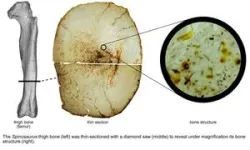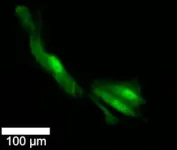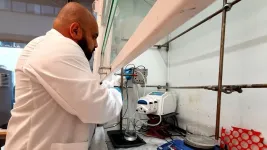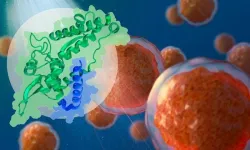(Press-News.org) For years, controversy has swirled around how a Cretaceous-era, sail-backed dinosaur—the giant Spinosaurus aegyptiacus—hunted its prey. Spinosaurus was among the largest predators ever to prowl the Earth and one of the most adapted to water, but was it an aquatic denizen of the seas, diving deep to chase down its meals, or a semiaquatic wader that snatched prey from the shallows close to shore?
A new analysis led by paleontologists from the University of Chicago reexamines the density of its bones as a way of determining its life habits in water.
Deep water swimmer or shoreline predator?
When detailed descriptions of a nearly complete specimen of Spinosaurus were first published in Science in 2014, a UChicago-led research team pitched it as a shoreline stalking or surface swimming demon, not a fully aquatic underwater predator (read more about the history of Spinosaurus and its initial discovery). Later in 2020, an international group of researchers countered that description with a study in Nature, using its newly discovered, tall-spined tail bones to suggest that it propelled itself like an eel to hunt underwater.
A 2022 Nature study by many of those same authors confirmed their 2020 assessment showing that Spinosaurus had dense bones to use as ballast in diving like a penguin. They also argued that some other spinosaurids, such as its older African cousin Suchomimus, had less dense bones and were likely waders.
About the same time in 2022, a group of paleontologists at UChicago teamed up with colleagues elsewhere to test these ideas by creating digital skeletons and flesh models of the Spinosaurus and Suchomimus. Their results, published in eLife, found that both species would have been unstable when swimming at the surface and far too buoyant to dive and fully submerge.
Now that same team has taken on the question of bone density, led by senior author Paul Sereno, PhD, from UChicago and first author Nathan Myhrvold, PhD, Founder and CEO of Intellectual Ventures. Their study, “Diving dinosaurs? Caveats on the use of bone compactness and pFDA for inferring lifestyle,” appeared in the journal PLOS ONE.
“We had made the thin sections of these species that were used for bone density calculations, and so we thought we would start by trying to replicate their measurements,” said Sereno, who is a Professor of Organismal Biology and Anatomy at UChicago and co-led the initial discovery of the new Spinosaurus specimen in 2014. “But we encountered many factors that generated a range of values—enough to undermine the conclusions.”
New calculations for ancient fossils
The team began by asking new questions about bone density, such as how to digitize thin sections, where to slice through the thigh and rib bones, and whether to include bones from more than one individual.
Some modern aquatic mammals like manatees have swollen, dense bones to help them stay underwater, like a scuba diver’s weight belt. Large land animals, like elephants and dinosaurs, also have dense bones to support their increased body mass. Most modern birds and many dinosaurs including Spinosaurus have the opposite condition, with air sacs attached to lungs or inside bones that act like a life vest preventing submergence. Assessing the aquatic abilities of an extinct species like Spinosaurus needs to take account of all these factors.
Given the complexity of understanding the meaning of bone density, Sereno and team worked with Myhrvold to reevaluate how the statistical technique used in the 2022 Nature study was applied to support the claim that Spinosaurus was a deep diver. The approach, known as phylogenetic flexible discriminant analysis (pFDA), is like machine-learning: the pFDA technique trains a classification algorithm on a group of species whose lifestyle is well understood.
In principle, researchers could then use the algorithm to estimate the likelihood that a poorly understood species such as Spinosaurus falls into one behavioral group or another. In practice, however, Myhrvold said there are problems that must be overcome.
“Unfortunately, that technique does not work properly unless you have lots of data, you make apples-to-apples comparisons, and you check that the data meet certain statistical prerequisites,” he said. “None of those requirements were met in that earlier study, so the results just didn’t hold up under reexamination.”
The new paper should help paleontologists understand the pitfalls of pFDA and other kinds of broad statistical analyses and how to avoid them. The researchers show that it is important to use consistent and objective criteria to decide which species to include and exclude, as well as how to classify their behavior. The findings also demonstrate the importance of taking measurement errors and individual variations into account when assessing bone density.
“We think Spinosaurus, one of the largest predatory animals ever to have evolved, needed extra bone strength to support its weight on its relatively short hind limbs,” Sereno said. “Spinosaurus was able to wade into waterways more than six feet deep without floating, where it could ambush fish of any size with its claws and jaws—but all while keeping its toes firmly anchored in the mud.”
Additional authors on the study include Stephanie L. Baumgart from the University of Florida; Daniel Vidal and Evan T. Saitta from UChicago; Frank E. Fish from West Chester University in Pennsylvania; and Donald M. Henderson from the Royal Tyrrell Museum of Paleontology, Alberta, Canada.
END
Giant dinosaur was “heron from hell,” not a deep diver, says new analysis
Study by UChicago paleontologists and colleagues uncovers major issues with earlier suggestions that the sail-backed mega-predator Spinosaurus pursued prey underwater.
2024-03-06
ELSE PRESS RELEASES FROM THIS DATE:
New deep-sea worm discovered at methane seep off Costa Rica
2024-03-06
Greg Rouse, a marine biologist at UC San Diego’s Scripps Institution of Oceanography, and other researchers have discovered a new species of deep-sea worm living near a methane seep some 50 kilometers (30 miles) off the Pacific coast of Costa Rica. Rouse, curator of the Scripps Benthic Invertebrate Collection, co-authored a study describing the new species in the journal PLOS ONE that was published on March 6.
The worm, named Pectinereis strickrotti, has an elongated body that is flanked by a row of feathery, gill-tipped appendages called ...
Nanosurgical tool could be key to cancer breakthrough
2024-03-06
The high-tech double-barrel nanopipette, developed by University of Leeds scientists, and applied to the global medical challenge of cancer, has - for the first time - enabled researchers to see how individual living cancer cells react to treatment and change over time – providing vital understanding that could help doctors develop more effective cancer medication.
The tool has two nanoscopic needles, meaning it can simultaneously inject and extract a sample from the same cell, expanding its potential uses. And the platform’s high level of semi-automation has sped ...
Genetic mutation in a quarter of all Labradors hard-wires them for obesity
2024-03-06
New research finds around a quarter of Labrador retriever dogs face a double-whammy of feeling hungry all the time and burning fewer calories due to a genetic mutation.
This obesity-driving combination means that dog owners must be particularly strict with feeding and exercising their Labradors to keep them slim.
The mutation is in a gene called POMC, which plays a critical role in hunger and energy use.
Around 25% of Labradors and 66% of flatcoated retriever dogs have the POMC mutation, which researchers previously showed causes increased interest in food ...
MIT scientists use a new type of nanoparticle to make vaccines more powerful
2024-03-06
CAMBRIDGE, MA -- Many vaccines, including vaccines for hepatitis B and whooping cough, consist of fragments of viral or bacterial proteins. These vaccines often include other molecules called adjuvants, which help to boost the immune system’s response to the protein.
Most of these adjuvants consist of aluminum salts or other molecules that provoke a nonspecific immune response. A team of MIT researchers has now shown that a type of nanoparticle called a metal organic framework (MOF) can also provoke a strong immune response, by activating the innate immune system — the body’s first line of defense against ...
A noninvasive treatment for “chemo brain”
2024-03-06
CAMBRIDGE, MA -- Patients undergoing chemotherapy often experience cognitive effects such as memory impairment and difficulty concentrating — a condition commonly known as “chemo brain.”
MIT researchers have now shown that a noninvasive treatment that stimulates gamma frequency brain waves may hold promise for treating chemo brain. In a study of mice, they found that daily exposure to light and sound with a frequency of 40 hertz protected brain cells from chemotherapy-induced damage. The treatment also helped to prevent memory loss and impairment of other ...
Film festivals are becoming more diverse in several ways, new study reports
2024-03-06
A group of Tallinn University researchers has published an innovative study that sheds light on the intricate dynamics of the global film festival circuit, revealing insights into diversity and public value creation within the industry. The research demonstrates that festival programming has become more thematically diverse, and the inclusion of films by women creatives has increased between 2012–2021.
The study “Quantifying the global film festival circuit: Networks, diversity, and public value creation,” published open access in the PLOS ONE journal, provides a comprehensive analysis of over 600 film festivals worldwide, spanning a period ...
New hydrogen producing method is simpler and safer
2024-03-06
Researchers in Sweden unveiled a new concept for producing hydrogen energy more efficiently, splitting water into oxygen and hydrogen without the dangerous risk of mixing the two gases.
Developed at KTH Royal Institute of Technology in Stockholm, the new method decouples the standard electrolysis process for producing hydrogen gas, which splits water molecules by applying an electric current. In contrast with prevailing systems it produces the resulting oxygen and hydrogen gases separately rather than simultaneously in the same cell, where they need to be separated by membrane barriers
That separation eliminates the possibility of the gases mixing with the risk of explosions, says ...
Studying the relationship between cancer-promoting proteins
2024-03-06
By Simonne Griffith-Jones, Predoctoral Fellow, EMBL Grenoble
Researchers from the Bhogaraju Group at EMBL Grenoble have gained new insights into how a cancer-relevant family of proteins bind their targets. The results of the study, published in The EMBO Journal, could potentially help in the development of drugs against certain chemotherapy- and radiotherapy-resistant cancers.
The Melanoma Antigen Gene (MAGE) family consists of more than 40 proteins in humans, most of which are only present in the ...
UTA educating schoolchildren about solar eclipse
2024-03-06
The University of Texas at Arlington has received a grant from the National Science Foundation (NSF) to support educational activities related to the upcoming eclipse.
UTA faculty and graduate students are visiting elementary, middle and high schools in the DFW area in March to give talks to about 4,000 students explaining the natural phenomena occurring during the eclipse and the physics behind it. UTA will also provide special eclipse glasses for students to use to avoid eye damage.
The $50,000 grant will also provide for about 1,500 students to take field trips to the UTA Planetarium, one of the three largest in Texas, to learn ...
Espresso yourself: Wearable tech measures emotional responses to coffee
2024-03-06
Researchers in Italy have introduced a novel approach for assessing the quality of coffee. In a pioneering new study, they have demonstrated the feasibility of using wearable technology to measure the emotional responses of coffee experts during tastings.
Published in SCI’s Journal of the Science of Food and Agriculture, the study provides an innovative solution for reducing judgement biases that can result from traditional and more subjective methods of coffee quality assessment.
Coffee is one of the most popular and widely consumed beverages in the world, ...
LAST 30 PRESS RELEASES:
Exposure to natural light improves metabolic health
As we age, immune cells protect the spinal cord
New expert guidance urges caution before surgery for patients with treatment-resistant constipation
Solar hydrogen can now be produced efficiently without the scarce metal platinum
Sleeping in on weekends may help boost teens’ mental health
Study: Teens use cellphones for an hour a day at school
After more than two years of war, Palestinian children are hungry, denied education and “like the living dead”
The untold story of life with Prader-Willi syndrome - according to the siblings who live it
How the parasite that ‘gave up sex’ found more hosts – and why its victory won’t last
When is it time to jump? The boiling frog problem of AI use in physics education
Twitter data reveals partisan divide in understanding why pollen season's getting worse
AI is quick but risky for updating old software
Revolutionizing biosecurity: new multi-omics framework to transform invasive species management
From ancient herb to modern medicine: new review unveils the multi-targeted healing potential of Borago officinalis
Building a global scientific community: Biological Diversity Journal announces dual recruitment of Editorial Board and Youth Editorial Board members
Microbes that break down antibiotics help protect ecosystems under drug pollution
Smart biochar that remembers pollutants offers a new way to clean water and recycle biomass
Rice genes matter more than domestication in shaping plant microbiomes
Ticking time bomb: Some farmers report as many as 70 tick encounters over a 6-month period
Turning garden and crop waste into plastics
Scientists discover ‘platypus galaxies’ in the early universe
Seeing thyroid cancer in a new light: when AI meets label-free imaging in the operating room
Neutrophil-to-lymphocyte ratio may aid risk stratification in depressive disorder
2026 Seismological Society of America Annual Meeting
AI-powered ECG analysis offers promising path for early detection of chronic obstructive pulmonary disease, says Mount Sinai researchers
GIMM uncovers flaws in lab-grown heart cells and paves the way for improved treatments
Cracking the evolutionary code of sleep
Medications could help the aging brain cope with surgery, memory impairment
Back pain linked to worse sleep years later in men over 65, according to study
CDC urges ‘shared decision-making’ on some childhood vaccines; many unclear about what that means
[Press-News.org] Giant dinosaur was “heron from hell,” not a deep diver, says new analysisStudy by UChicago paleontologists and colleagues uncovers major issues with earlier suggestions that the sail-backed mega-predator Spinosaurus pursued prey underwater.










